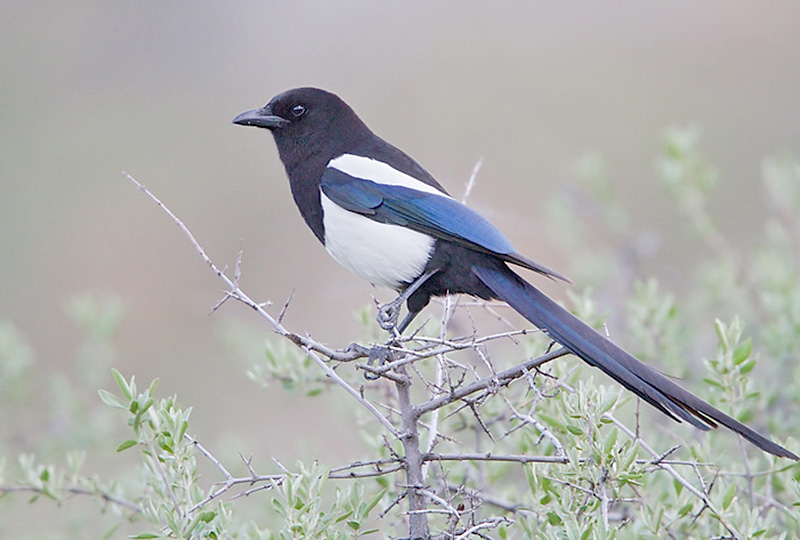
The birds of Montana include 445 species found in this scenic state!
The wide open spaces of Montana are a haven for birds. Many species nest in the prairies and wetlands of eastern Montana, and the Rocky Mountains match scenery with wonderful birding in the west.
How many birds of Montana have you seen?
We bet you’ve seen a lot!
But how many were you able to identify?
This list of common backyard and wild birds in Montana will help!
On this page
- What Are The Most common Birds of Montana?
- Black-billed Magpie
- Black-capped Chickadee
- Northern Flicker
- American Robin
- Common Raven
- Mallard
- Canada Goose
- European Starling
- House Finch
- Red-winged Blackbird
- Eurasian Collared-Dove
- House Sparrow
- Red-breasted Nuthatch
- Song Sparrow
- Dark-eyed Junco
- American Crow
- Red-tailed Hawk
- Bald Eagle
- Mountain Chickadee
- American Goldfinch
- Pine Siskin
- Downy Woodpecker
- Rock Pigeon
- Killdeer
- Western Meadowlark
- Mourning Dove
- Cedar Waxwing
- Yellow Warbler
- Yellow-rumped Warbler
- Common Goldeneye
- American Coot
- Tree Swallow
- Ring-billed Gull
- Gadwall
- Common Merganser
- FAQ
What Are The Most common Birds of Montana?
Montana is a beautiful state with an abundance of wild habitats and many birds. With so many bird species possible, it helps to know which ones are most common.
To make the best, reliable list of common birds in Montana, we researched data from eBird sightings. We then arranged those species from most common to least common.
Based on data!
PS! Remember that species on the bottom of the list are common birds too!
To help with identification, we also included information about their field marks and behavior.
Black-billed Magpie
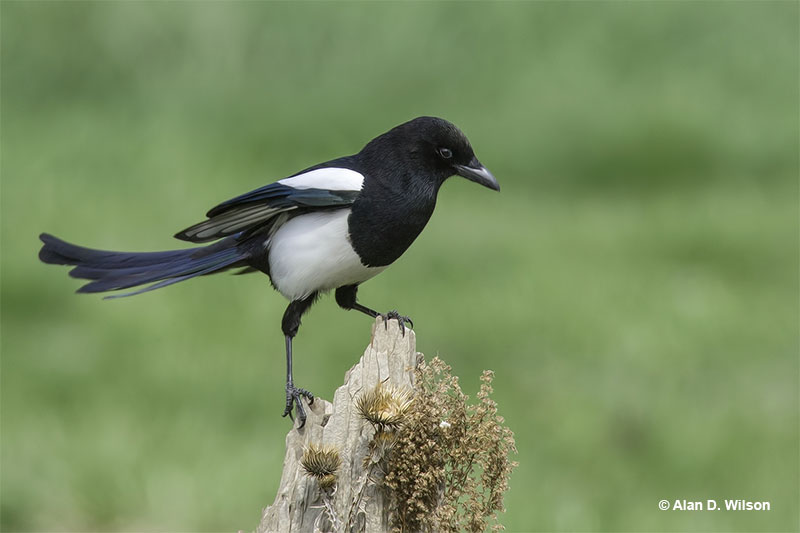
Scientific name: Pica hudsonia
Length: 19 inches
Weight: 6 ounces
Wingspan: 25 inches
Song: “reh reh reh reh reh!”
The Black-billed Magpie is a big, bold, black and white bird with a long tail. This relative of crows and jays has a stout, crow-like beak and glossy green and purple in its wings and tail.
Males and females look alike and also show bold white wing patches in flight. These birds fly with a few flaps followed by short brief glides and usually occur in groups.
They are omnivorous and eat a wide variety of food items. In winter, magpies often scavenge animals killed by predators as well as roadkill. They and also eat insects, small animals, seeds, and other items.
Black-billed Magpies make domed nests out of sticks and mud, and build them in trees and on poles and other structures.
This species lives in a variety of open, semi-open, and wooded habitats in Alaska, western and central Canada, and much of the western USA south to New Mexico.
Key Identifications:
- Medium to large black and white bird with a black beak, and a long, glossy green and purple tail.
- Feeds on carrion, small animals, seeds, and other food scraps.
- Makes a domed nest out of mud and sticks.
- This vocal bird makes a repeated raspy vocalization, “reh reh reh reh reh!”.
The Black-billed Magpie is a bold black and white bird with a long tail. They often occur in groups that forage on carrion, small animals, and other food scraps. This species often perches on cows, Moose, and other large herbivores to eat the ticks that attach to these large animals.
Black-capped Chickadee
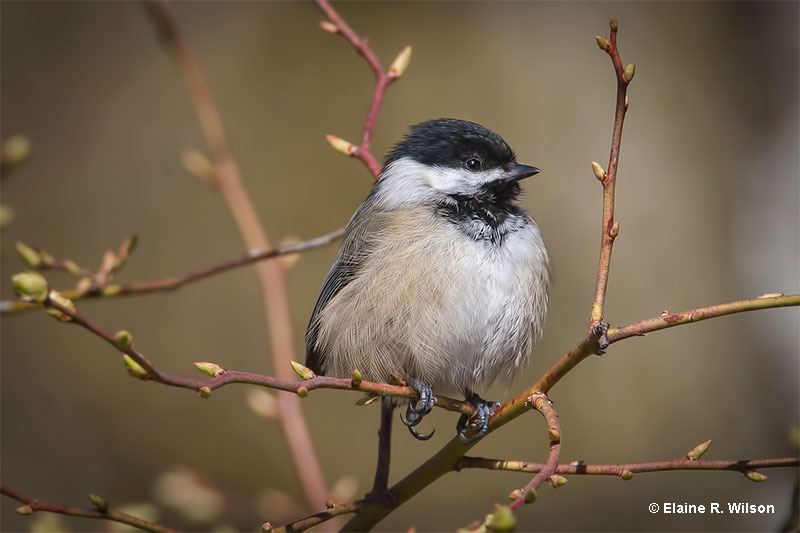
Scientific name: Poecile atricapilla
Length: 5.25 inches
Weight: .39 ounces
Wingspan: 8 inches
Song: “see bee, see bee”
Black-capped Chickadees are small grayish birds with a black cap, black throat, and a stubby black beak. Both sexes look alike and have a white face, white edging to the feathers in their wings, and some buff on their underparts.
These cute little birds feed on caterpillars, insects, spiders, seeds, and fruit. They are regular visitors to feeders but also forage on bark, twigs, and in foliage. When foraging, they often hang upside down from twigs and usually occur in small flocks.
This species makes a small, soft nest out of moss and deer hair. It builds its nest in tree cavities and can also use nest boxes.
Black-capped Chickadees live in a variety of wooded habitats and can also occur in gardens. They are year-round residents in parts of Alaska, Canada, and the northern USA south to Oregon, northern New Mexico, northern Ohio, and the Appalachian Mountains to North Carolina.
Key Identifications:
- Small, cute, grayish birds with a black cap, white face, and a black throat.
- Forages for insects, spiders, seeds, and fruit in wooded habitats. Also visits feeders.
- Nests in tree cavities and nest boxes.
- This little bird is quite vocal and often says its name, “chick-a-deedeedeedeedee”. They also make other chattering calls and sing a whistled song, “see bee, see bee”.
The Black-capped Chickadee is a small, acrobatic bird with a black cap, white face, and a black throat. It is also a state bird of Massachusetts. They usually forage in flocks with other chickadees and other small birds, and often visit feeders. This species hides dozens of seeds and other bits of food for the winter, and recalls where each of these food items are hidden.
Northern Flicker
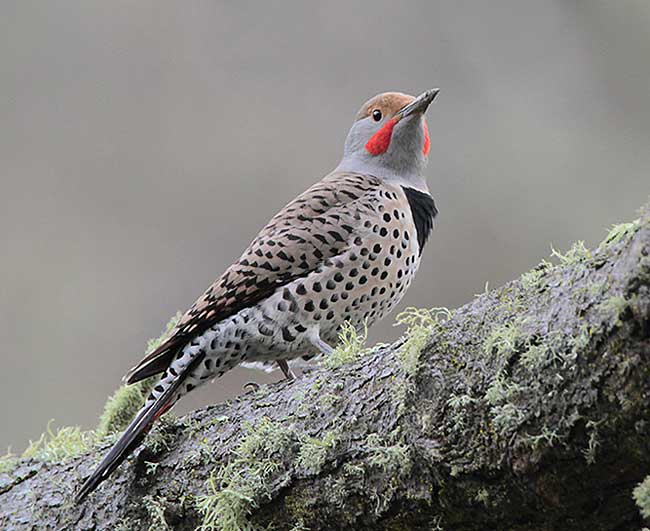
Scientific name: Colaptes auratus
Length: 12.5 inches
Weight: 4.6 ounces
Wingspan: 20 inches
Song: “kick,kick,kik,kik,kik.kik.kik.kik.kik.kik.kik.kik!”
Northern Flickers are fairly large, tan and gray woodpeckers with barring on their backs. They have a black mark on their breast, black spotting below, and a dark, stout beak.
Males in the east have a tawny throat and face with a black moustache and small red spot on the back of their heads. Males in the west have mostly gray heads with a red moustache.
Female Northern Flickers look like males but lack the moustache mark.
In bounding flight, they have white rumps and flash color on their underwings. This is bright yellow in eastern birds and reddish in flickers west of the Rocky Mountains.
This woodpecker eats many ants and other insects that it catches on the ground. It forages by flying to the ground, locating anthills, and lapping them up with its long tongue.
Northern Flickers nest in tree cavities and live in wooded and open habitats in Canada, the USA, and Mexico.
Key Identifications:
- Tan and gray woodpecker with black barring above, black marks below, and a bright, white rump.
- Forages for ants and other insects on the ground.
- Nests in tree cavities.
- A vocal woodpecker, the Northern Flicker often gives loud, “flicka,flicka,flicka” calls, and another loud, single note that sounds like, “Keer!” They also have a long, laughing vocalization of repeated notes, “kick,kick,kik,kik,kik.kik.kik.kik.kik.kik.kik.kik!”.
Northern Flickers are fairly big, tan woodpeckers with gray highlights, a white rump, and black markings. They mostly forage for ants on the ground in open and wooded areas. The red-shafted Northern Flickers in the west used to be considered a separate species from the yellow-shafted flickers of the east. At present, they are considered to be one species because they frequently hybridize with each other.
American Robin
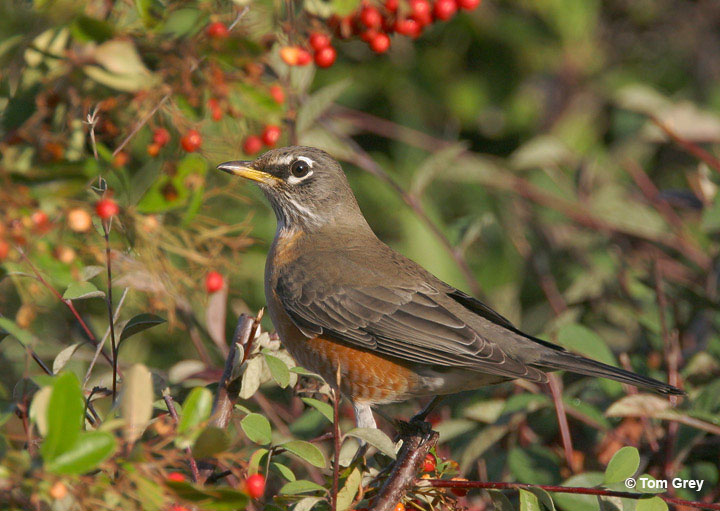
Photograph © Tom Grey
Scientific name: Turdus migratorius
Length: 10 inches
Weight: 2.7 ounces
Wingspan: 17 inches
Song: “cheery, cheery, cheery, cheery, cheer, cheer”
The American Robin is a familiar and common thrush that is dark gray above and brick red below. It also has an orange-yellow bill, a blackish head with white markings around the eyes and on the throat, and a white belly.
Both sexes of this thrush species are similar but males are darker above and more reddish on the underparts. Young American Robins have more white marks on their faces and spotting on orange underparts.
In flight, this common thrush in Montana also shows white corners in its outer tail feathers.
American Robins forage on the ground for worms, insects, snails, and other small creatures. In winter, these common birds flock together and perch in trees and bushes to eat berries and fruit.
The American Robin makes a cup nest in trees and lives in parks, woodlands, towns, and many other habitats. They reside in Alaska, most of Canada, the USA and in Mexico.
Key Identifications:
- Fair-sized songbird that is dark gray above, and brick red and white below.
- Forages for worms and bugs on lawns and other open grassy areas, also flocks together to feed on fruiting trees in the winter.
- Makes a cup nest in trees.
- The American Robin is quite vocal and makes a loud, sharp, “yenk!” call and quieter “check,check,check” calls. It also has a lovely cheerful song of caroled phrases, “cheery, cheery, cheery, cheery, cheer, cheer”.
The American Robin is a common, handsome thrush with dark gray upperparts and brick red and white underparts. It forages for worms and bugs on lawns and other open, grassy spots, and also eats berries. Populations of the American Robin have been estimated at 370,000,000; a number that gives this bird the distinction of being the most numerous landbird in North America.
Common Raven
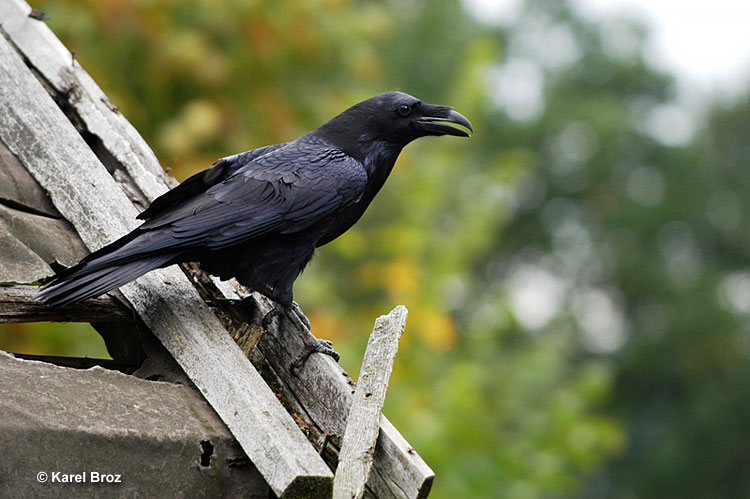
Scientific name: Corvus corax
Length: 24 inches
Weight: 2.6 pounds
Wingspan: 53 inches
Song: “Grauk Grauk Grauk Grauk!”
The Common Raven is a big, black crow-like bird with long, broad wings and a broad, wedge-shaped tail.
Both sexes look alike and have feathers extending onto the top part of their strong, stout beaks.
This bird is often seen in soaring flight or in direct flight where it gives a few strong flaps between glides.
Common Ravens are omnivores that feed on carrion, small animals, nesting birds, and various other food items. They forage by flying above roads and other places and are always on the lookout for feeding opportunities.
This big Corvid makes a big, bulky nest out of sticks and lines the shallow cup with mud, wool, and other items. It builds its nest on a cliff, tree, bridge, or other structure.
The Common Raven lives in wilderness areas from the Arctic to parts of the northeastern USA and the western USA. In some places, it lives in urban areas. Common Ravens are common in Montana.
Key Identifications:
- Huge, black, crow-like bird with a strong, stout beak and a wedge-shaped tail.
- An omnivore that feeds on small animals, carrion, and other food items.
- Makes a big bulky stick nest in trees, on cliffs, and on human-made structures.
- Common Ravens are vocal birds. One of their most common calls is a load and croaking, “Grauk Grauk Grauk Grauk!”.
The Common Raven is a large, black, crow-like bird of mountains, forest, tundra, and other wild areas. Some also live near people and, in flight, they can sometimes be mistaken for raptors. However, no hawk species is entirely black with a wedge-shaped tail. The Common Raven can mimic human speech and is one of the most intelligent bird species.
Mallard
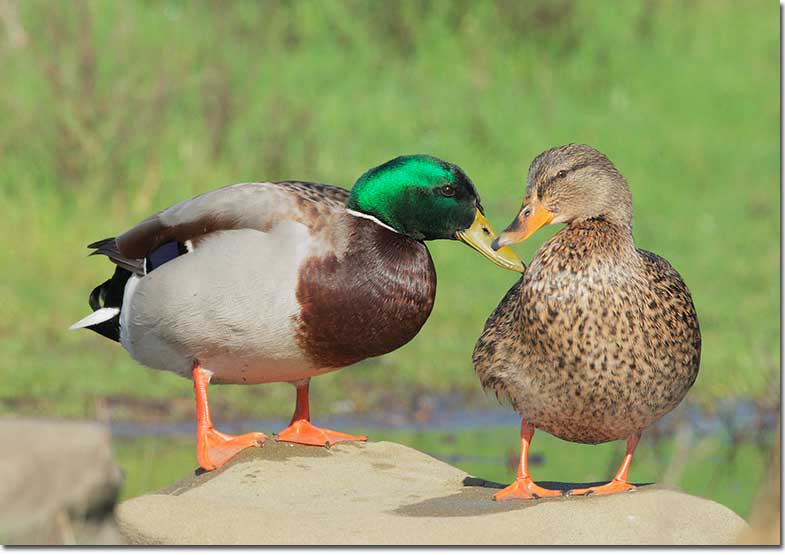
Mallard pair (Male and female)
Scientific name: Anas platyrhynchos
Length: 23 inches
Weight: 2.4 pounds
Wingspan: 35 inches
Song: “quack, quack”
The Mallard is a fairly large, familiar duck. The male has a metallic green head, yellow bill, narrow white ring around the neck, and chestnut breast. The rest of the bird is pale gray with pale brown, and black on its back and around his tail.
Female Mallards are mottled brown and buff with a dark crown and line through the eyes, and have a dark gray and orange beak.
In flight, both sexes show a green-blue wing patch bordered with white.
Mallards eat a variety of items including insect larvae, snails, other small aquatic creatures, acorns, seeds, and grain. They forage by filtering and picking up food items in and near shallow water, and in farm fields.
This duck species makes a shallow nest with sticks and lined with down feathers. It builds its nest on the ground, hidden in grass or under a bush.
The Mallard lives in ponds, marshes, and many wetland habitats in Canada, USA, and Eurasia.
Key Identifications:
- Large and familiar duck, male has dark green head, white ring around the neck, and a chestnut breast. Female is mottled buff and brown, and has a dark gray and orange beak.
- Feeds on insect larvae, grain, seeds, and other items picked up with its bill in and near shallow water.
- Makes a shallow stick nest hidden in grass or under a bush.
- The female Mallard makes the classic “quack, quack” duck sound. Males make similar but softer sounds and a whistling call.
The Mallard is a fairly large and familiar duck with a dark green head (the male), or is buff and brown with a dark gray and orange beak (the female). Thus duck species often lives near people and occurs on lakes, ponds, and other wetlands. No matter how different they look, most small domestic duck species are descended from wild Mallards.
Canada Goose
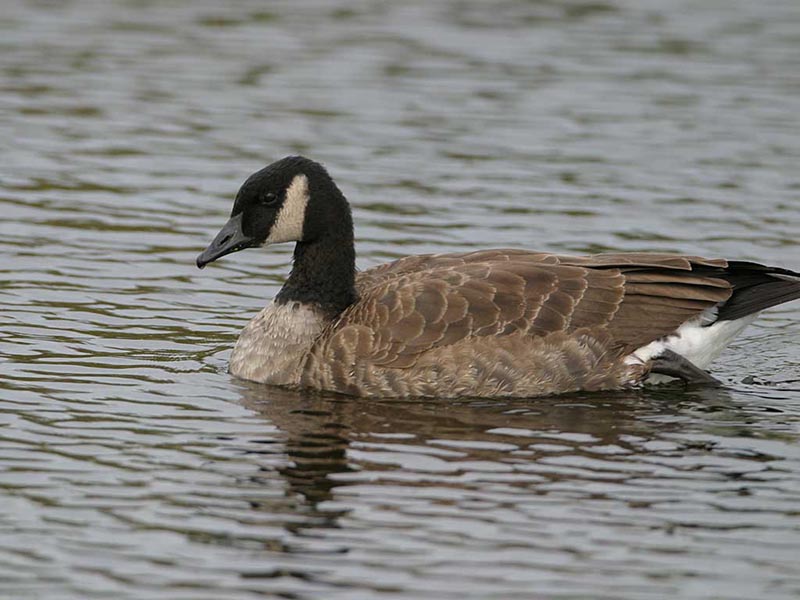
Scientific name: Branta canadensis
Length: 35 – 45.2 inches
Weight: 5.29 – 19.8 pounds
Wingspan: 50 – 67 inches
Song: “uurrRUNK! uurrRUNK!”
The Canada Goose is a large, grayish-brown bird with a long black neck, and black head with a white throat and cheeks. Males and females look alike and have pale barring, a white belly and undertail, and a short black and white tail.
They have strong direct flight and make deep flaps with long, broad wings.
Canada Geese feed on grass, sedges, and other vegetation, grain, and berries. They forage by walking along and grazing, or picking food from the ground and bushes. This species also feeds by dipping its head below the surface of shallow water.
This large goose uses grass and other plants to make a large, shallow cup nest on a small mound or other elevated spot next to water.
The Canada Goose prefers open grassy areas and farm fields near water where it can feed and see predators before they get too close. They live in Alaska, most of Canada, and most of the USA, being one of the most common birds of Montana.
Key Identifications:
- Big, gray-brown goose with a long black neck, and black and white head.
- Grazes vegetation and forages for berries in wide open, grassy habitats near water like golf courses, parks, and airports.
- Makes a shallow, open cup nest on an elevated spot next to water.
- Vocal and often makes honking calls, “uurrRUNK! uurrRUNK!”.
Canada Geese are a large, common goose species with long black necks, and a black and white head. These big birds are a common sight on golf courses and other places that combine open lawns and water. When the Canada Goose and other birds migrate in “V” formation, they expend less energy than flying on their own.
European Starling
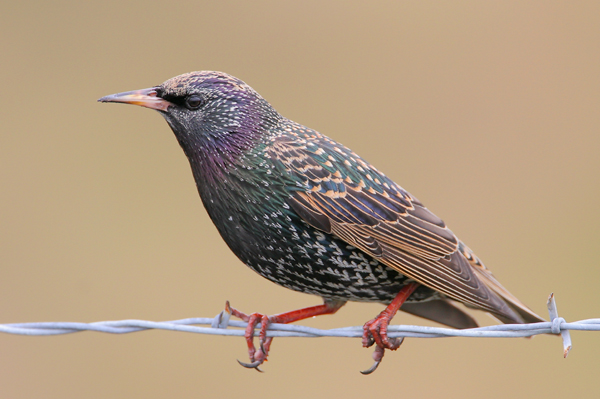
Photograph © Greg Lavaty.
Scientific name: Sturnus vulgaris
Length: 8.5 inches
Weight: 2.9 ounces
Wingspan: 16 inches
Song: “tiktiktitZHREEree..tiktiktik..ZHREE”
European Starlings are plump, short-tailed birds with long sharp beaks and longish, pointed wings. In summer, they have yellow beaks, glossy black plumage with purple and green highlights, and some small white spots.
Males and females are similar but males have less spotting and glossier plumage. In winter, they have black beaks, white spots, and more reddish colors in their wings.
Young starlings are shaped like adults but are grayish birds with a dark beak and a pale throat.
This species feeds on a variety of insects, fruit, and seeds. They can dominate bird feeders and are common species in urban areas, parks, farmlands, and other open habitats.
This European Starling builds a soft cup nest in a tree cavity, nest box, or suitable cavity in other structures.
European Starlings flock with each other and blackbird species, especially during the winter. They live across a large part of Canada and the USA.
Key Identifications:
- Rotund, short-tailed bird with a long, sharp beak, and pointed wings. Glossy black with some spotting in the summer and blackish with heavy white spotting and streaking in the winter.
- Feeds on seeds, fruit, and insects. Visits feeders and forages on the ground in flocks.
- Builds a soft cup nest in nest boxes and other cavities.
- The European Starling makes a wide variety of mechanical and whistled sounds. They also mimic other birds and sounds in their environment. They sing long, jumbled mechanical-sounding songs, “tiktiktitZHREEree..tiktiktik..ZHREE”.
European Starlings are rounded, blackish birds with long, sharp beaks and short tails. They live in towns, cities, parks, on farms, and in other open habitats. This species forms large flocks called, “murmurations” that move in coordinated patterns.
House Finch
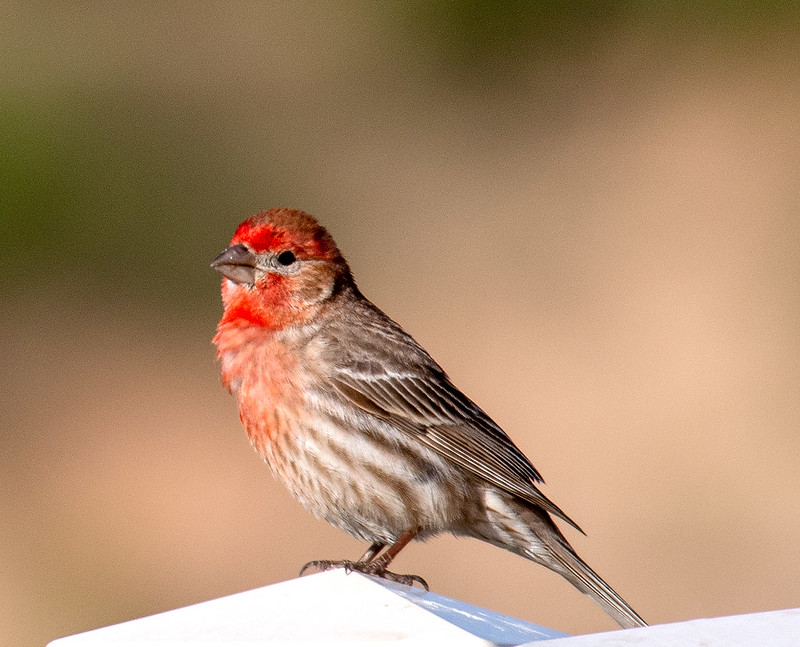
Photograph © John Hansen
Scientific name: Haemorhous mexicanus
Length: 6 inches
Weight: .88 ounces
Wingspan: 10 inches
Song: “chip,chip,chiprididip,ZREEYachip”
House Finches are sparrow-sized birds with dark, rounded beaks and fairly long wings. Males are orange-red or rose-red on their head, throat and breast, and have some red on their rump. They also have brownish streaks on their back, flanks, and white belly.
Like the male, female House Finches have two white wing bars on long, gray-brown wings. However, they lack red and are mostly streaked, dull brown-gray birds.
House Finches feed on seeds, buds, fruit, and flowers. They often visit feeders in Montana but also forage on the ground, and in bushes and trees.
We see these pretty birds in deserts and arid zones, and in parks, farmland, urban areas, and other semi-open habitats.
The House Finch makes a soft cup nest built on a tree, building ledge or other spot with some overhanging cover. They often occur in small groups and live in southern Canada, most of the USA, Mexico, and Hawaii.
Key Identifications:
- Reddish or plain gray-brown, streaked, sparrow-like bird.
- Eats seeds, flowers, buds, and fruit. Can visit feeders but also forages on the ground and in bushes and trees.
- Makes a soft cup nest in trees, on building ledges, and other places.
- The House Finch often makes a soft, “fidip” call. Males also sing a warbling song from prominent, high perches. It sounds like, “chip,chip,chiprididip,ZREEYachip”.
House Finches are sparrow-like, reddish or brownish, streaked birds. They live in arid zones as well as in parks and urban areas. All of the millions of House Finches that live east of the Rocky Mountains are descendants of birds released on Long Island in 1939.
Red-winged Blackbird
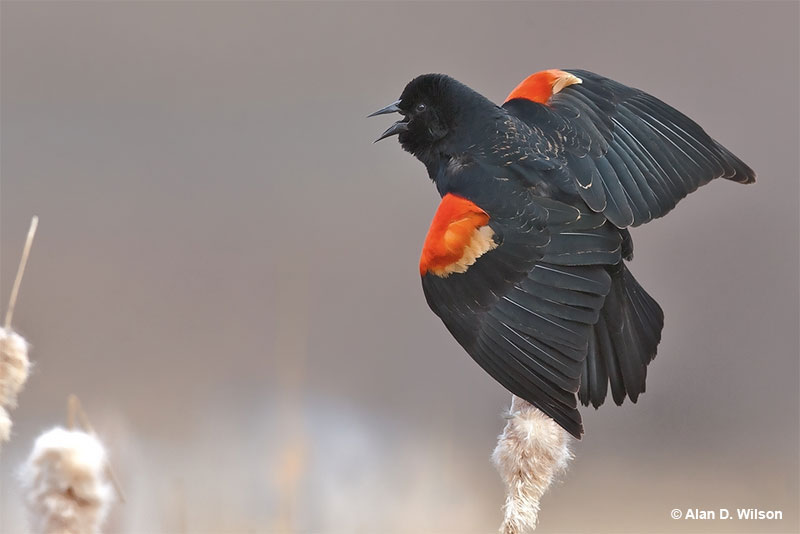
Scientific name: Agelaius phoeniceus
Length: 8.75 inches
Weight: 1.8 ounces
Wingspan: 13 inches
Song: “kan-keree!”
The Red-winged Blackbird is a medium-sized blackbird species with a sharp, all black bill. Males also have a scarlet patch with a pale yellow border on the shoulder of each wing.
Female Red-winged Blackbirds are dark, heavily streaked, brownish-gray birds with an orange-buff eyebrow and throat. She can also have a little bit of dingy red on her shoulder.
Red-winged Blackbirds often flock together and can form very large groups in the winter. They feed on seeds, grain, and insects found on lawns, in marshes, farm fields, and other open habitats.
This species builds a cup nest made of leaves and dead stems in a bush or other low vegetation in a marsh, park, or brushy field.
Red-winged Blackbirds are very common birds that live in all sorts of open habitats. We see them in parks, farming areas, and marshes in much of Canada, the USA, Mexico, and parts of the Central America.
Key Identifications:
- Males are medium-sized blackbirds with a bright red patch on their wings. Females are heavily streaked, have a sharp black beak, and buff on the head.
- Feeds on seeds, grain, and insects on the ground in many open habitats.
- Builds a cup nest in a bush or other low vegetation.
- Red-winged Blackbirds often call. Males sing a loud, “kan-keree!” and both sexes also make “check!” calls and a high-pitched whistle-like sound.
The Red-winged Blackbird is a common, social species easily seen in marshes and open habitats. In the winter, it can form huge flocks that feed in farm fields. This species can make a daily commute of 50 miles to and from roosting and feeding sites.
Eurasian Collared-Dove
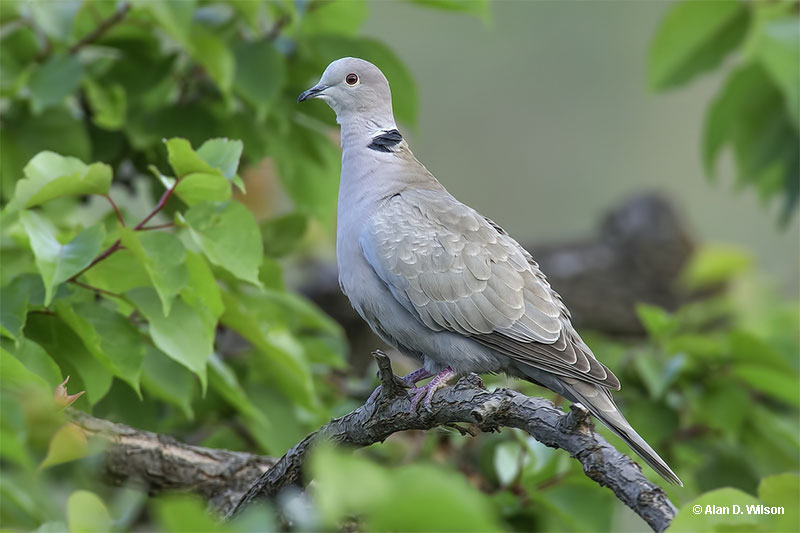
© Alan D. Wilson
Scientific name: Streptopelia decaocto
Length: 13 inches
Weight: 7 ounces
Wingspan: 22 inches
Song: “hoo hoo hoowuh hoo WUH hoowuh hoo WUH!”
The Eurasian Collared-Dove is a medium to large, pale tan and gray dove with a black mark on its nape. Males and females look similar, have a slender black beak, and a narrow gray eyering.
Eurasian Collared-Doves have black primaries and white in their tail feathers. These field marks are especially visible in flight.
These doves feed on grain and seeds picked from the ground and they can also visit feeders. In some places, Eurasian Collared-Doves occur in large flocks, especially around farms and grain silos.
The Eurasian Collared-Dove makes messy stick nests in trees and on structures near people. This species is highly adapted to living with and near people and prefers to feed in farm fields, gardens, towns, and other places where they can find grain and seeds.
This Eurasian species was accidentally introduced to North America in the 1970s and 1980s. It now occurs in parts of Alaska and much of Canada and the USA, including Montana.
Key Identifications:
- Fairly large, pale tan and gray dove with black primaries and white in its longish tail.
- Forages for grain and seeds on the ground.
- Makes messy stick nests in gardens, parks, and on farms.
- This dove species often calls and makes a typical dove-like sound, “hoo hoo hoowuh hoo WUH hoowuh hoo WUH!”.
The Eurasian Collared-Dove is a fair-sized pale tan and gray dove with much white in its longish tail. These birds can probably only survive near people and live in gardens, towns, and on farms. When drinking water, this species uses its beak like a straw.
House Sparrow
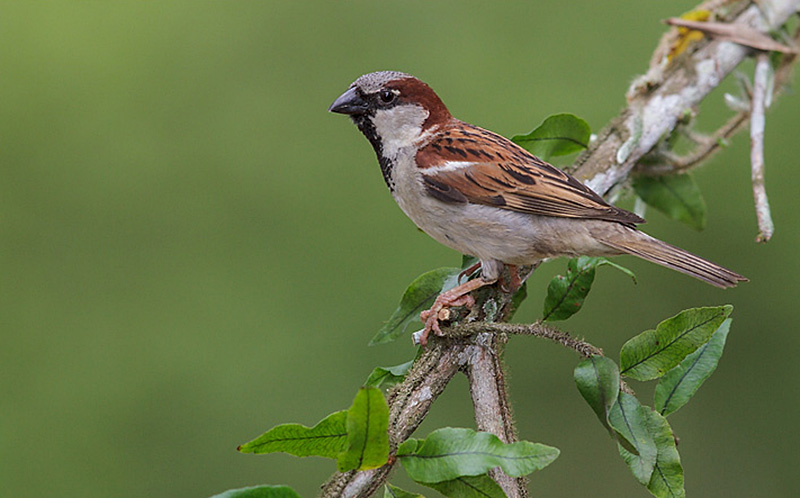
House Sparrow (Passer domesticus) perched on a branch in the Atlantic rainforest of southeast Brazil.
Scientific name: Passer domesticus
Length: 6.25 inches
Weight: .98 ounces
Wingspan: 9.5 inches
Song: “see,chirrup,see,chirrup,see,chirrup”
House Sparrows are small, plump gray and brown birds with conical, finch-like beaks. Males have a gray and rufous head with pale cheeks, and black near their eyes and on their throat.
The rest of their underparts are gray and they have brown, streaked backs with rufous highlights. They also have a white mark in the shoulder of each wing and a grayish rump and tail.
Females are plainer brown and buff, have paler beaks, and buff eyebrows.
House Sparrows feed on seeds, grain, and insects. They are regular visitors to bird feeders and often dominate other smaller species. They also forage on the ground in farmlands, parks, urban areas, and other open situations.
The House Sparrow nests in cavities. When searching for suitable nesting sites, they can kill and remove the eggs and young of smaller species like Eastern Bluebirds.
House Sparrows usually live near people and occur in most of North America, including Montana.
Key Identifications:
- Brown and gray sparrow with a bold pattern on its head.
- Feeds on seeds, grain, and insects at feeders and on the ground in urban areas and farmlands.
- Nests in tree cavities, including nest boxes.
- This species is vocal and often makes short chirping calls. Its song is a friendly series of chirping sounds, “see,chirrup,see,chirrup,see,chirrup”.
In many places, the House Sparrow is the common urban sparrow. It occurs in pairs and small groups that forage on sidewalks, in parking lots, farm fields, and other familiar places. This species is one of the very few birds that has evolved to live with people and digest the same grains that we eat.
Red-breasted Nuthatch

© Elaine R. Wilson
Scientific name: Sitta canadensis
Length: 4.5 inches
Weight: .35 ounces
Wingspan: 8.5 inches
Song: “yeank, yeank, yeank”
The Red-breasted Nuthatch is a small, warbler-sized bird with a dark gray, straight or slightly upturned beak, gray upperparts, and reddish-orange underparts. It also has a black cap, a white face with a narrow black mask, and black and white in its short tail.
Males and females are similar except that females are paler and have a gray cap.
Red-breasted Nuthatches eat insects during the summer and conifer seeds in the winter. These small, animated birds forage by creeping down coniferous tree trunks and on branches. They use their bills to probe bark and pick out insects and seeds.
This species excavates a tree cavity and makes an open nest of bark and other vegetation.
The Red-breasted Nuthatch lives in coniferous and mixed forests in southern Alaska, Canada, and the western and northern USA. They also breed in the Appalachians and can be seen in most of the USA in winter.
Key Identifications:
- Small, short-tailed bird with a narrow white eyebrow, black mask, gray upperparts, and reddish-orange underparts.
- Creeps along tree trunks and branches to forage for insects and conifer seeds.
- Nests in tree cavities.
- The distinctive nasal call of the Red-breasted Nuthatch, “yeank, yeank, yeank”, is a good way to find this bird.
The Red-breasted Nuthatch is a small, short-tailed bird with black and white on its head, gray upperparts, and reddish-orange underparts. It usually occurs alone and lives in coniferous woods and trees. To protect its nest, this species puts sticky pine resin around the border of its nesting hole.
Song Sparrow
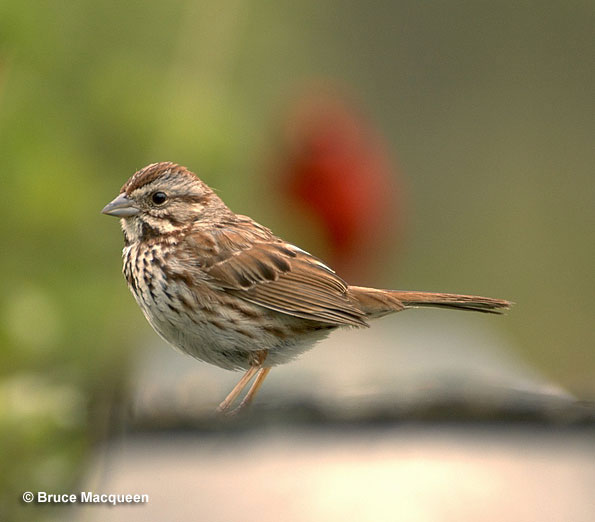
Scientific name: Melospiza melodia
Length: 6.25 inches
Weight: .7 ounces
Wingspan: 8.25 inches
Song: “seet serate sitsziziziziziziziz seet”
The Song Sparrow is a small, gray and brown, streaked songbird with a thick dark mark on each side of its white throat. Males and females look the same and have white underparts with a dark brown mark on their breast, and dark brown streaks on their breast and sides.
Most Song Sparrows also have two narrow wing bars and show a rounded tail when fluttering between bushes.
This species feeds on insects, seeds, and small fruits. Pairs forage by picking up food items on and near the ground. They are also frequent visitors to bird feeders.
Song Sparrows use grass, stems, hair, and other materials to make a cup nest placed on or near the ground. They nest in dense vegetation, shrubbery, or low trees, often near water.
This species uses a wide variety of brushy habitats in open and wooded situations in southern Alaska, most of Canada, and all of the USA.
Key Identifications:
- Small brown, streaked sparrow with a dark mark on its breast.
- Forages on and near the ground for seeds and insects in brushy habitats.
- Builds a cup nest on or near the ground in a shrub or low tree.
- Makes high-pitched “tink”, chirping calls, and has a cheerful song with a trill, “seet serate sitsziziziziziziziz seet”.
Song Sparrows are reddish-brown songbirds with dark brown streaks and a dark brown breast patch on white underparts. They usually occur in pairs and are often heard and seen in brushy areas and large gardens. There are several subspecies with distinct plumages including a large, dark one that lives on the Aleutian Islands.
Dark-eyed Junco
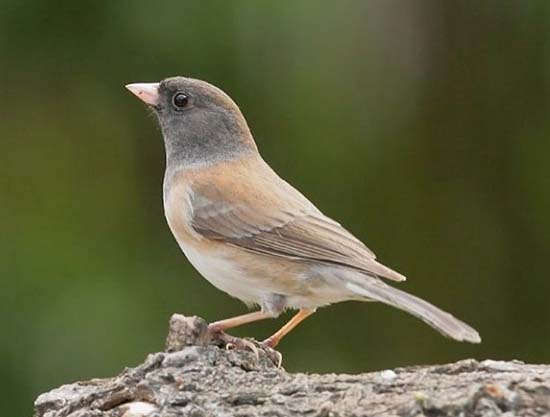
Scientific name: Junco hyemalis
Length: 6.25 inches
Weight: .67 ounces
Wingspan: 9.25 inches
Song: “sipsipsipsipsipsipsip”
Dark-eyed Juncos are sparrow-like birds with pale conical bills and dark eyes. This small bird has variable plumage with most being slate gray or gray and brown with white on their bellies, and white under their tails.
Other plumages include birds with dark masks and faint white wing bars, juncos with pale gray hoods and pinkish sides, and birds with blackish hoods and chestnut sides.
In flight, all Dark-eyed Juncos show extensive white in their longish tails.
This species feeds on seeds, insects, and some fruit and grain. Juncos forage on the ground in wooded areas, parks, and other habitats. They also feed on fallen seed beneath feeders.
They build cup nests on the ground under fallen logs, in roots, and other hidden spots. After breeding, juncos form flocks that forage together in similar wooded and semi-open habitats.
Dark-eyed Juncos are common birds in Canada, the USA, and parts of Mexico.
Key Identifications:
- Sparrow-like gray and brown bird with dark eyes, a pale beak, and white in the tail.
- Forages for seeds and insects on the ground, can feed on seeds at and beneath feeders.
- Builds a cup-shaped nest on the ground in tree roots, under logs, and other hidden places.
- This species often makes a sharp, high-pitched chip note, “pik!”. On breeding grounds, males sing a short, plain trill, “sipsipsipsipsipsipsip”.
Dark-eyed Juncos are sparrow-like, gray and brown birds with much white in the tail. Common wintering birds in many areas, they forage for seeds on the ground in wooded and park-like habitats. In many places, this common species is also known the “Snowbird” on account of only occurring in the winter months and having white on the belly and tail.
American Crow

Scientific name: Corvus brachyrhynchos
Length: 17.5 inches
Weight: 1 pound
Wingspan: 39 inches
Song: “Caw! Caw!”
The American Crow is a big, all black bird with a strong, stout bill. In certain lighting, it can have metallic purple and blue iridescence.
Both sexes look the same and have some feathering on their beaks, long, broad wings, and a broad tail.
American Crows have direct flight with strong, steady wing beats. Crows are very social and intelligent birds that are usually seen in flocks. They forage together on the ground or in trees and eat just about anything they can find.
Some of their more regular foods include carrion, fruit, nuts, seeds, insects, and small animals. Like most jays and crow species, they also eat the eggs and nestlings of other bird species.
This species builds bulky stick nests high in trees and lives in most habitats except for high mountains and arid zones.
The American Crow occurs in southern Alaska and much of Canada and the USA.
Key Identifications:
- Big, all black bird with long, broad wing and a broad tail.
- Forages for carrion, fruit, seeds, insects, and small animals.
- Builds a bulky stick nest high in a tree.
- American Crows are very vocal birds. They can make several calls but their most common one is, “Caw! Caw! Caw!”.
The American Crow is a common, large black bird that frequently calls, “Caw! Caw! Caw!”. It usually occurs in flocks and lives in all sorts of places, even urban zones. These birds are very smart and have funerals or wakes! When a crow dies, other crows mark the occasion by gathering together and loudly calling.
Red-tailed Hawk
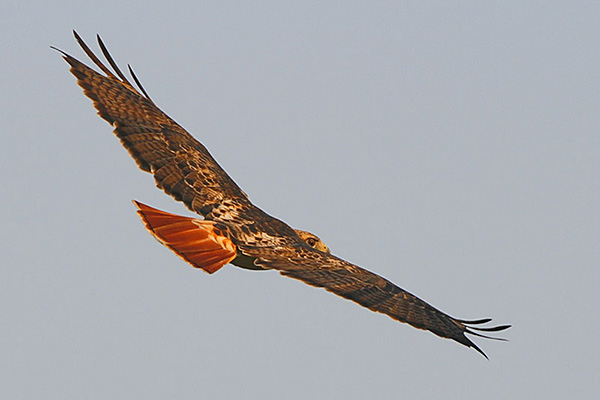
Scientific name: Buteo jamaicensis
Length: 19 inches
Weight: 2.4 pounds
Wingspan: 49 inches
Song: “Kreeeyahh!”
The Red-tailed Hawk is a large and chunky raptor with a broad, orange or reddish tail. Males and females look alike although females are larger.
These raptors are dark brown above and are pale below with dark markings on their belly. Young birds are more streaked on their underparts, and have brown tails with dark barring.
Red-tailed Hawks often soar and have long, broad wings that can show pale square patches on the bases of their primaries. While soaring, they watch for squirrels and other small animals that they feed on.
When they spot prey, these big birds drop down to catch it with their talons. This hawk also hunts by watching for prey from a perch.
The Red-tailed Hawk builds a large, bulky, stick nest high in trees. They thrive in a wide variety of habitats but especially in woodlands near fields and other open habitats.
This raptor lives from Alaska and Canada south to Central America.
Key Identifications:
- Large, bulky hawk with a broad, reddish tail.
- Catches squirrels, rats, pigeons, and many other small animals on the ground.
- Nests in large, bulky nests made of sticks.
- A vocal raptor, Red-tailed Hawks often call in flight. They usually give a “classic” but quiet sounding raptor scream, “Kreeeyahh!”.
Red-tailed Hawks are large dark brown and pale hawks with broad, reddish tails. The most common raptor in many areas, they often perch on powerline poles along roads. The Red-tailed Hawk’s vision is eight times better than a person’s; they can spot a tiny rodent while soaring 100 feet above it.
Bald Eagle
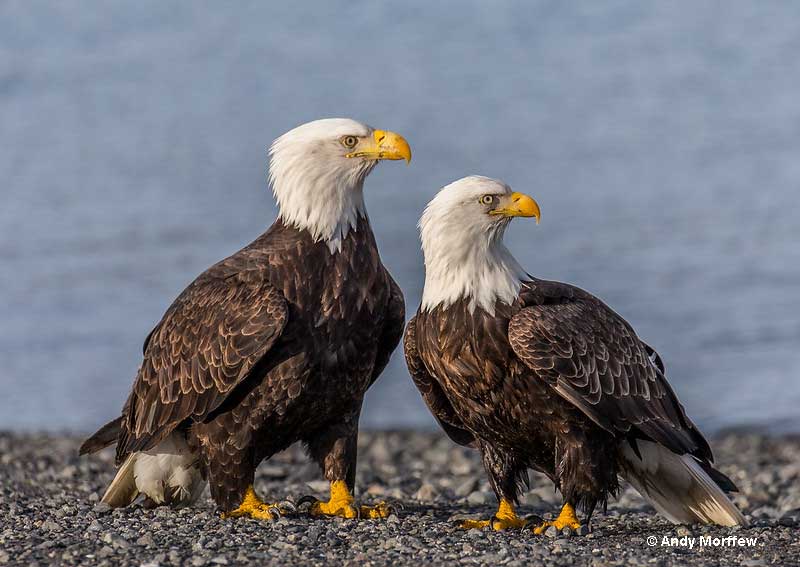
Judging by the size, female is on the left and male is on the right. Photograph © Andy Morffew
Scientific name: Haliaeetus leucocephalus
Length: 31 inches
Weight: 9.5 pounds
Wingspan: 80 inches
Song: “pip pipipipip!”
The Bald Eagle is a huge, dark brown raptor with a white head, white tail, and a big yellow beak. Males and females look the same except that females are bigger.
Young birds are dark brown with mottled white and have a mostly dark beak.
In flight, Bald Eagles soar on broad, long wings held flat like a board. They also have deep and slow wing beats.
The Bald Eagle snatches fish from the surface of lakes, rivers, and other shallow wetlands. It also feeds on carrion and occasionally catches small mammals and birds as big as a Canada Goose.
This big raptor builds a big, bulky stick nest high in a tree in or near wetlands. They often use the same nest year after year.
Bald Eagles occur in a variety of wetland habitats in Alaska, Canada, most of the USA (including Montana), and in some parts of northern Mexico.
Key Identifications:
- Although adult Bald Eagles are unmistakable, young birds can be confused with the Golden Eagle. They are best recognized by their mottled plumage, huge beak, and flat, soaring wings.
- Preys on fish, small mammals, ducks and geese, and also eats carrion.
- Builds a big, bulky nest out of sticks in wetland habitats.
- Bald Eagles make brief, whistled piping calls, “pip pipipipip!”.
The Bald Eagle is a huge raptor with a white head and tail, young birds are dark brown with white mottling. This bird of prey catches fish and aquatic animals and feeds on carrion in many wetland habitats. Persecution and DDT poisoning eliminated Bald Eagles from most of the lower 48 states in the first half of the 20th century. Since then, thanks to legal protection and reintroduction programs, this majestic bird has come back and thrives in most parts of its range.
Mountain Chickadee
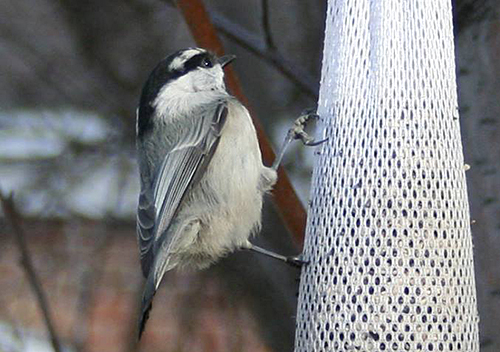
Scientific name: Poecile gambeli
Length: 5.25 inches
Weight: .39 ounces
Wingspan: 8.5 inches
Song: “pifeeee bee bee!”
The Mountain Chickadee is a small, pale, frosty gray bird with a black cap, white eyebrow, and black throat. Both sexes look alike and have small, stout black beaks.
This species mostly feeds on beetles, caterpillars, aphids, other insects, and spiders. It finds food by picking these food items from coniferous twigs and branches. The Mountain Chickadee usually forages in flocks with other chickadees and warblers.
Mountain Chickadees also visit bird feeders at any time of the year and forage for seeds of pinyons and other conifers in the winter.
This small cute bird makes a soft, cup nest of moss, lichen, and animal fur. It builds its nest in a tree cavity, nest box, or in tree roots.
Mountain Chickadees are year-round residents of coniferous forests in western Canada and the western USA. As long as conifers are present, they can also occur riparian zones.
Key Identifications:
- Small frosty gray bird with a black cap, black throat, and white eyebrow.
- Picks insects and spiders from coniferous vegetation, also eats conifer seeds in winter, and at feeders.
- Makes a soft cup nest of moss, lichen and fur in tree cavities or nest boxes.
- Often calls and makes a, “chick a dee dee dee” vocalization and a whistled, pifeeee bee bee”.
The Mountain Chickadee is a frosty gray bird with a black cap, white eyebrow, and black throat. It forages in flocks with other small birds in montane coniferous forests of western North America. When disturbed at its nest, this species makes s snake-like hissing noise.
American Goldfinch
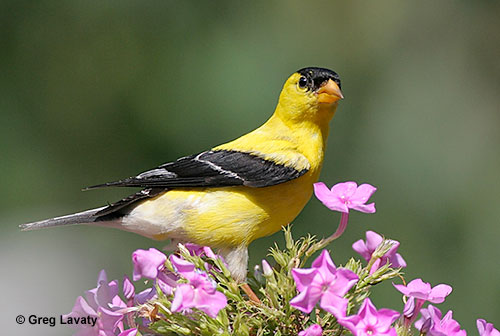
American Goldfinch
Scientific name: Carduelis tristis
Length: 5 inches
Weight: .46 ounces
Wingspan: 9 inches
Song: “swit sweet, sipsipsipchichisweetsweet”
The American Goldfinch is a small, sparrow-sized finch with a black and white, slightly forked tail, pale rump, and white undertail. In summer, males are bright lemon yellow with a small black cap, pale beak, and have some white markings on long black wings.
Females and wintering birds have two pale wings bars and have plain gray, buff, and yellowish plumage. This species often occurs in small flocks and has bounding flight.
American Goldfinches feed on seeds. They forage by picking them from grass, thistle, other low plants, Alders, and other trees. Goldfinches are also frequent visitors to bird feeders.
The American Goldfinch uses plant matter and other soft materials to build a small, tightly woven cup nest high in a shrub or a low tree.
American Goldfinches are summer residents in southern Canada, California, and the northern half of the USA, and winter in most of the USA and parts of Mexico.
Key Identifications:
- Small, bright yellow finch with a black cap, wings and tail (summer male), female and winter males are plain brown, buff, and yellowish birds with two pale wing bars.
- Feeds on seeds in low plants, trees, and at feeders.
- Makes a tightly woven cup nest high in a shrub or low tree.
- Often gives a “per chickory” call in flight and sings a short, trilled song, “swit sweet, sipsipsipchichisweetsweet”.
American Goldfinches are small, common finches that frequent weedy and brushy fields, second growth, parks, and backyards. Outside of the breeding season, they occur in small flocks and often visit feeders. Brown-headed Cowbirds that hatch in American Goldfinch nests die after a few days because they can’t survive on a diet of seeds.
Pine Siskin
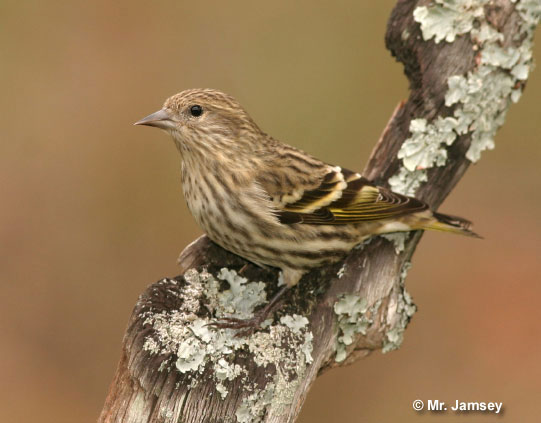
Scientific name: Carduelis pinus
Length: 5 inches
Weight: .53 ounces
Wingspan: 9 inches
Song: “chupchup chititititi zhreeee chittitititchititichichup”
The Pine Siskin is a small, grayish-brown finch with a sharp, thin, conical beak. Males and females have brown streaking above and much streaking on their underparts.
They both have a white belly, long wings, and a rather short, slightly forked tail.
However, females have two white wing bars while males have one or two yellow wing bars. Males can also have more yellow in their plumage, including in their tail.
Pine Siskins eat a wide variety of seeds. They forage for grass seeds, and seeds of coniferous and deciduous trees like Alder and Birch. This species is also regular at seed feeders.
This finch species makes a small cup nest out of moss, lichens, grass, and other bits of vegetation.
The Pine Siskin breeds in boreal forest in Canada and parts of the northern USA, and in coniferous forests in the western USA. It winters in many parts of the USA, Canada, and parts of Mexico.
Key Identifications:
- Small, grayish-brown, streaked finch with wing bars and a thin conical beak.
- Forages in trees, bushes, and at feeders for seeds.
- Makes a small cup nest of moss and other bits of vegetation, high in a tree.
- Has a long, complex, hurried songs of chittering and harsh notes, “chupchup chititititi zhreeee chittitititchititichichup”. Also makes some brief call notes and a rising call, “zhreeee”.
The Pine Siskin is a gray-brown, streaked finch with two wing bars and a thin, conical beak. It breeds in coniferous forest but winters in a wide variety of habitats. When cone crops fail in the north, thousands of Pine Siskins can winter well south of their typical range.
Downy Woodpecker
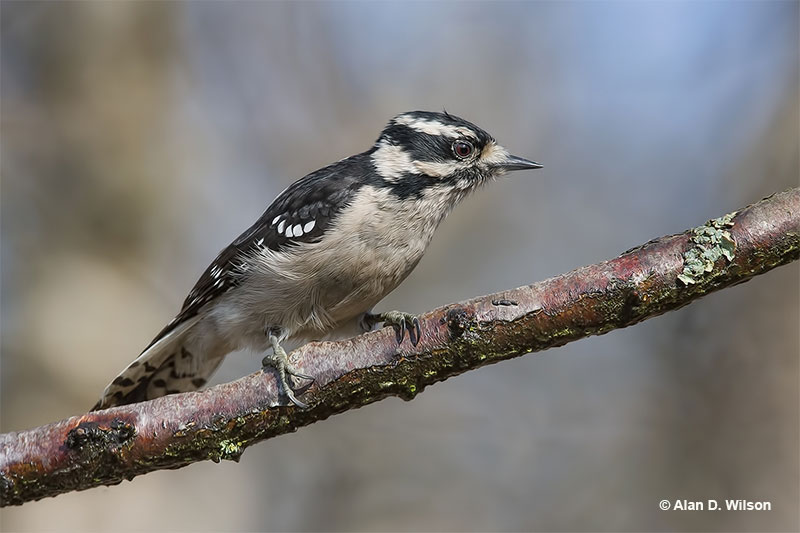
Scientific name: Dryobates pubescens
Length: 6.75 inches
Weight: .95 ounces
Wingspan: 12 inches
Song: “Pik! Ch,ch,ch,ch,ch,ch,ch!”
The Downy Woodpecker is a small black and white woodpecker with a short, black beak. They are patterned black and white above and have white backs and white underparts. Both sexes look alike except that males have a small, bright red patch on the top back part of their head.
Young birds look like adults but have a reddish patch on the top of their head. Downy Woodpeckers also have a few small black marks in their white outer tail feathers, and a small white tuft at the base of their beak.
This woodpecker eats insects, other small creatures, seeds, and small fruits. It pecks into live and dead wood and often forages on smaller branches and twigs. These friendly little woodpeckers are also common feeder birds.
They nest in tree cavities and live in gardens and a wide variety of woodlands. We see Downy Woodpeckers in much of Canada and the USA but not in arid habitats.
Key Identifications:
- Smallest woodpecker in North America. Mostly black and white with a short, black beak.
- Forages on trees, in bushes, and at feeders for insects, seeds, and suet.
- Nests in tree cavities.
- The Downy Woodpecker makes sharp “pik!” calls and also has a trilled call, “Ch,ch,ch,ch,ch,ch,ch!“.
Downy Woodpeckers are the smallest woodpecker species in North America and usually occur in pairs. They can also forage with other small birds and often visit feeders. This species takes advantage of its size to peck into the stems of weeds and other plants too small for larger woodpeckers to perch on.
Rock Pigeon
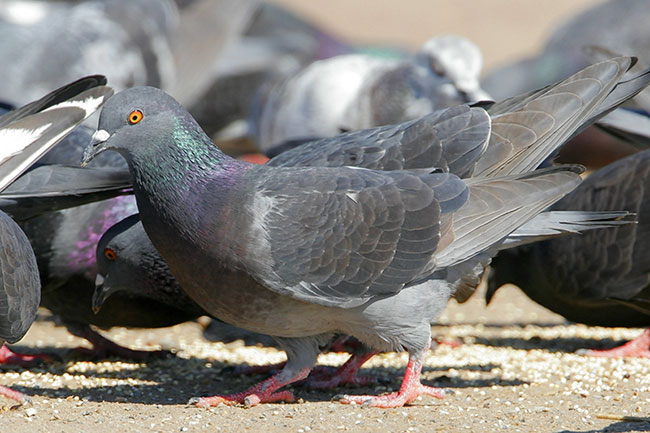
Scientific name: Columba livia
Length: 12.5 inches
Weight: 9 ounces
Wingspan: 28 inches
Song: “tititik grewh”
The Rock Pigeon is the familiar and common “pigeon” of cities, farms, and other urban situations. Although this pigeon can show a variety of plumages, the most frequent one is pale gray with dark gray on the head and neck, and a dark gray tail with a dark tip.
It also has iridescent green on its neck and two black wing bars.
This species has quick and direct flight with rapidly beating wings.
Rock Pigeons usually occur in flocks and large ones can form in farm fields and some urban areas. They pick seeds and grain from the ground, mostly in open areas like farm fields, parks, and city streets.
The Rock Pigeon uses sticks and other stick-like objects to make a shallow nest on covered ledges of buildings and other structures.
Rock Pigeons are completely adapted to living with people and occur in urban and farming areas in most parts of North America, including Montana.
Key Identifications:
- Familiar gray pigeon with dark tip at the end of its tail and two black wing bars.
- Picks seeds and grain from the ground of streets, fields, and other open habitats.
- Makes messy stick nests on ledges with overhanging structures.
- Makes a gruffy vocalization, “tititik grewh”.
This species is the common and familiar city pigeon. Rock Pigeons are darker than other doves and feed on the ground in farm fields and streets. Truly wild Rock Pigeons are shy and only live on remote cliffs in Europe and Asia.
Killdeer
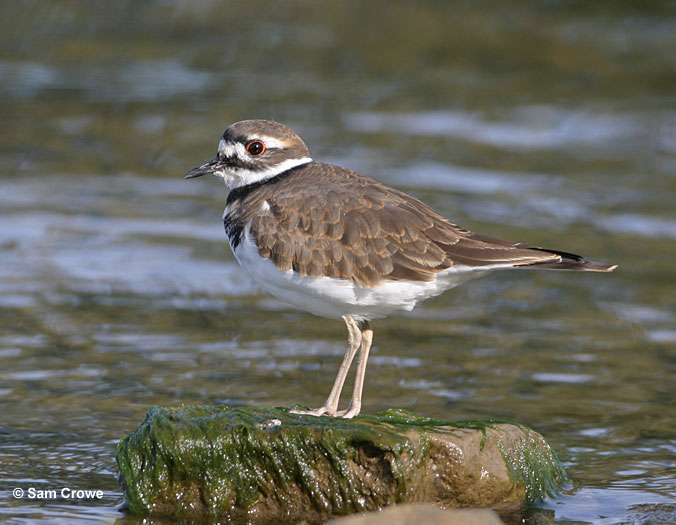
Scientific name: Charadrius vociferus
Length: 10.5 inches
Weight: 3.3 ounces
Wingspan: 24 inches
Song: “tideer, tideer, tideer, tideer”
The Killdeer is a fair-sized, slender plover that is dark brown above and white below. They have two black bands on their breast, a patterned, black, white, and dark brown face, and a longish, orange tail.
Both sexes look alike and also have a slender, black bill, narrow, red-orange eyerings, and long, pale legs. In flight, we can see a white stripe in each of their long, dark wings, and a black tip on their long, wedge-shaped, orange tail.
Killdeers often fly high overhead in fast, direct flight but we usually see them foraging on the ground. They pick insects, other small creatures, and seeds from the edges of wetlands and other, open grassy areas.
This species lays its camouflaged eggs on the ground, in gravel and open fields. When people and pets approach too close, they give loud calls and pretend to have a broken wing.
The Killdeer lives in large parts of Canada, the USA, Mexico and also Montana.
Key Identifications:
- Fair-sized plover with two black breast bands and a wedge-shaped orange tail with a black tip.
- Picks seeds and small creatures from open ground.
- Lays camouflaged eggs on the ground, in gravel and open fields.
- Very vocal and sounds like it says its name, “tideer, tideer, tideer, tideer”.
The Killdeer is the most common and familiar shorebird in much of its range and occurs in many open habitats. It is the only plover in North America with two black breast bands and has a longish, orange tail with a black tip. To scare cows near their nests, Killdeers fluff themselves to look bigger, raise their tail over their head, and run at the large animal.
Western Meadowlark
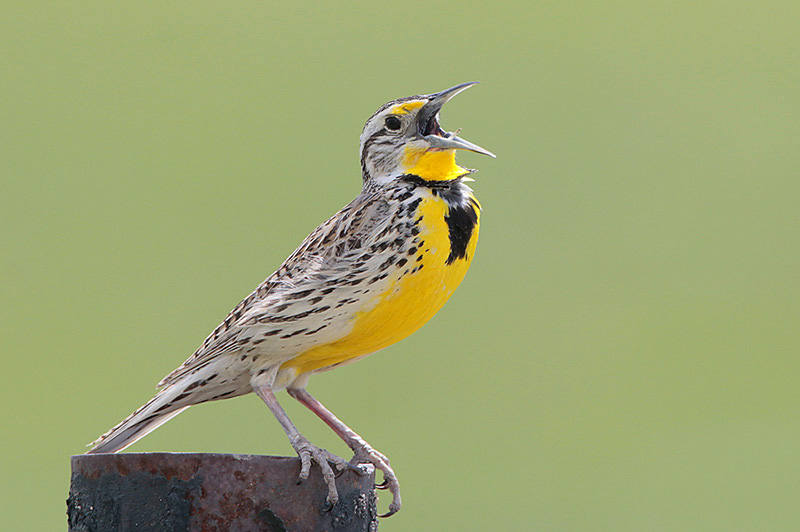
Scientific name: Sturnella neglecta
Length: 9.5 inches
Weight: 3.4 ounces
Wingspan: 14.5 inches
Song: “trip tree tur ripuhdip”
Western Meadowlark in also a state bird of Montana!
The Western Meadowlark is a chunky, pale brown and yellow bird with a long straight beak. Males and females look alike and have a large black “V”-shaped mark on their bright yellow breast. The rest of their underparts are white with some dark marks on their flanks.
They also have a narrow white stripe down the middle of their dark crown, a long yellow and white eyebrow, and a pale face with a dark line going back from their eyes.
This bird shows white in the tail, especially in flight, and also has a little bit of yellow on the lower part of the face.
Western Meadowlarks forage on the ground in open habitats for insects and seeds.
This species uses grass and other bits of vegetation to make a hidden nest on the ground.
The Western Meadowlark lives in a variety of open habitats in parts of Canada, the central and western USA, and Mexico. They are common birds of Montana.
Key Identifications:
- Robin-sized, pale brown and yellow rotund bird with a black “V” mark on its breast.
- Forages for insects and seeds on the ground in open habitats.
- Makes a hidden, dome-like nest out of grass and soft vegetation, on the ground.
- This birds has a rattle call, often in flight, and sings a pleasant, melodious whistled song, “trip tree tur ripuhdip”.
The Western Meadowlark is a chunky pale brown and yellow bird with a black “V” mark on its breast. Pairs are conspicuous in wide open habitats of central and western North America. On account of its beautiful song and appearance, this conspicuous bird was chosen to be the official bird for six different states.
Mourning Dove
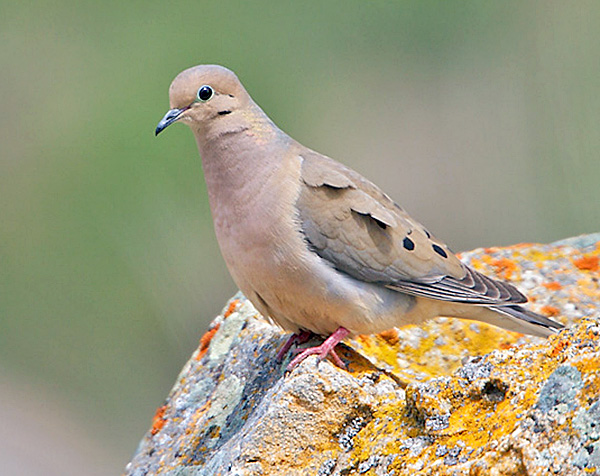
Photograph © Greg Lavaty.
Scientific name: Zenaida macroura
Length: 12 inches
Weight: 4.2 ounces
Wingspan: 18 inches
Song: “hooOOA, hoo, hoo, hoo”
Mourning Doves are medium-sized, grayish-brown doves with long tails. They have small black spots on their wings and a small head with a slender, dark beak.
Males and females also have narrow gray eyerings, a black mark on the face, and pale iridescent gold on the sides of their necks. They look alike except for males having more gray on the head and neck, and more iridescence.
This dove has fairly long wings and swift, direct flight. When flying, it shows black and white in its tail.
The Mourning Dove occurs in woodlands, gardens, on farms, and in urban areas. This common feeder visitor eats seeds and grains. It also forages in open situations, picking food from the ground.
This pleasant dove species can visit a feeder on its own or forage in small flocks. It builds an unkempt stick nest in bushes and trees and is very common throughout the USA, southern Canada, and Mexico.
Key Identifications:
- Plain brown and gray dove with a long, pointed tail.
- Feeds on seeds at feeders and on the ground in open areas.
- Makes a small, messy nest of sticks in trees.
- Sings a sad and owl-like “hooOOA, hoo, hoo, hoo”.
The Mourning Dove is the common garden dove in most of its range. It often visits feeders and its cooing song is commonly mistake for an owl. This species has a short lifespan with many adults only living for a couple of years or less.
Cedar Waxwing
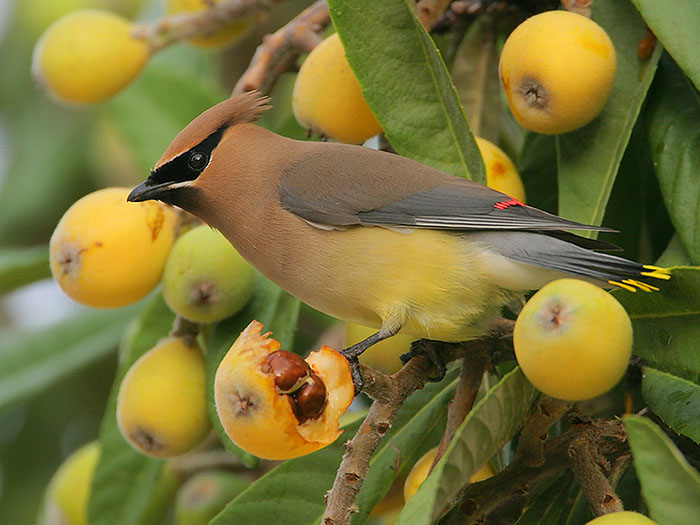
Scientific name: Bombycilla cedrorum
Length: 7.25 inches
Weight: 1.1 ounces
Wingspan: 12 inches
Song: “sree…zree!”
The Cedar Waxwing is a thrush-sized, crested bird with a black mask, black throat, and sleek, pale brown, gray, and yellow plumage. Both sexes look similar and have bright yellow on the tip of their tail, and a pale yellow belly.
Young birds are grayish-brown with some thick streaks on white underparts. Adult Cedar Waxwings also have a few small red dots on their wings, and have a white undertail.
This species feeds on insects and small fruits. In summer, waxwings often sally into the air to catch bugs in flight. However, they mostly feed on berries and forage for them in large flocks, especially in the winter.
The Cedar Waxwing constructs a bulky, open cup nest out of moss, flowers, bark, other bits of plants, and other materials. It builds its nest in an isolated tree or bush.
Cedar Waxwings breed in a large area of Canada and occur in the northern half of the USA, making it one of the most common birds of Montana.
Key Identifications:
- Sleek, pale brown and gray crested bird with a black mask, black throat, and a bright yellow tip on its tail.
- Catches insects in flight and visits fruiting and trees and bushes to feed on berries.
- Uses bark and other materials to make an open cup nest in an isolated tree or bush.
- Cedar Waxwings are very vocal and often make a soft, whispering call, “sree…zree!”.
The Cedar Waxwing is a thrush-sized, pale brown and gray bird with a crest, black throat, and black mask. They usually occur in groups that flock to fruiting trees. This frugivorous species can become intoxicated after eating too many fermented berries!
Yellow Warbler
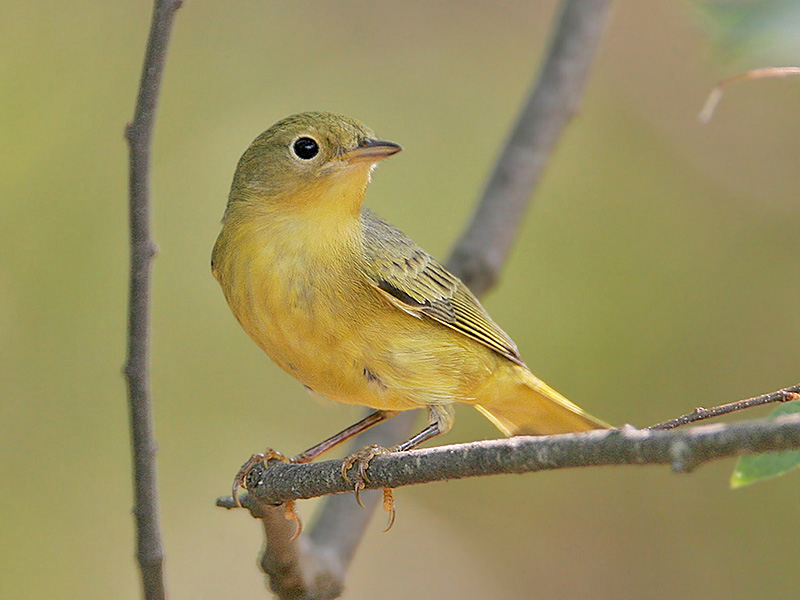
Scientific name: Setophaga petechia
Length: 5 inches
Weight: .33 ounces
Wingspan: 8 inches
Song: “sweet sweet sweet swisisi sweet”
The Yellow Warbler is a small yellow bird with a sharp beak. Both sexes are yellow birds with olive-yellow upperparts, and have long wings with a hint of two yellow wing bars.
Males in breeding plumage are brighter yellow and have chestnut streaks below. Females and juveniles lack streaks and are duller. All Yellow Warblers have yellow spots in their tails.
Yellow Warblers feed on various insects and arthropods. They forage by quickly moving through vegetation and picking food from the foliage. They can also sally to catch insects in flight.
This species uses grass, bark strips, plant fiber, and other materials to make a deep cup nest. It builds it in a bush or small tree.
The Yellow Warbler breeds in a variety of second growth habitats in Alaska, Canada, much of the western USA, and in the eastern USA south to northern Georgia. It winters in edge habitats from Mexico to northern South America.
Key Identifications:
- Small yellow bird with a sharp beak. Males have chestnut streaks below.
- Forages for insects in bushes and trees, usually in edge habitats.
- Makes a deep cup nest of bark strips and plant fibers in a bush or low tree.
- Has a sweet-sounding sound of ringing notes, “sweet sweet sweet swisisi sweet”. It also makes sharp chip calls.
The Yellow Warbler is a small, yellow bird with a sharp beak. This species is common in edge habitats and second growth, especially along waterways. Yellow Warblers are often parasitized by Brown-headed Cowbirds. If the warbler detects a cowbird egg, it usually builds a new nest right on top of the old one.
Yellow-rumped Warbler
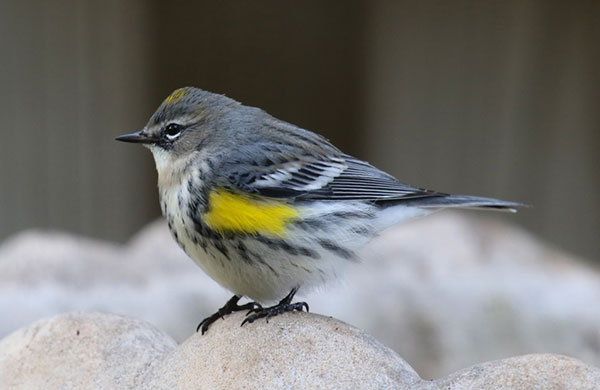
Scientific name: Setophaga coronata
Length: 5.5 inches
Weight: .42 ounces
Wingspan: 9.25 inches
Song: “si,sit,sit,sit,sit,sue,sue,sue”
The Yellow-rumped Warbler is a small, blue-gray songbird with a yellow rump, crown, and yellow patches on each side of its breast. It also has two white wing bars, dark marks on the back, and white underparts with blackish markings on its breast and sides.
In summer, this species has a blackish face and white markings above and below the eyes. Females are like males but duller. In winter, both sexes of Yellow-rumped Warblers are duller and have more brownish plumage.
The western subspecies has a yellow throat and more white in the wings.
This species feeds on insects and small berries. It picks food from vegetation and briefly flies into the air to catch bugs in flight.
Yellow-rumped Warbler build small cup nests in conifers in Canada and the northeastern and western USA. They spend the winter in semi-open habitats from the southern USA to Central America.
Key Identifications:
- Small songbird with two pale wing bars and yellow patches on the rump, each side of its breast, and crown.
- Feeds on insects and small berries.
- Builds cup nests in conifers in northern and montane forests.
- The Yellow-rumped Warbler makes a sharp call note, “chup!”, and sings a brief and easy-going warbling song, “si,sit,sit,sit,sit,sue,sue,sue”.
Yellow-rumped Warblers are small, blue-gray or brownish songbirds with two pale wing bars, and yellow patches on the crown, sides of the breast, and rump. In winter, they occur in small flocks that feed on insects and berries in parks and other semi-open habitats. The eastern subspecies is known as the “Myrtle Warbler” and the yellow-throated western subspecies is called, “Audubon’s Warbler”.
Common Goldeneye
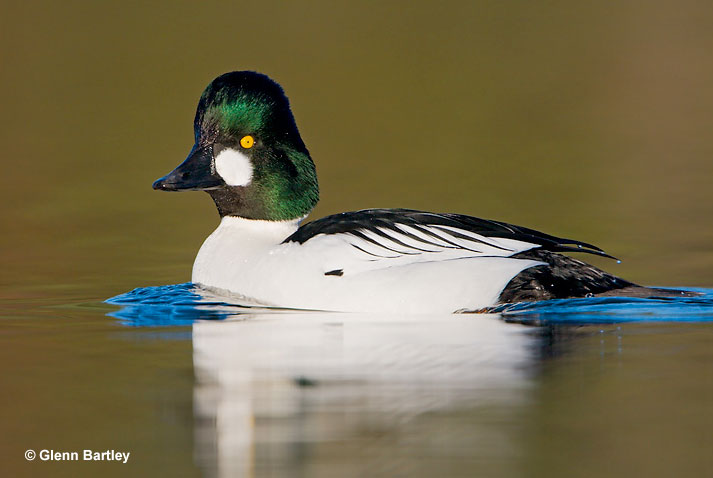
Scientific name: Bucephala clangula
Length: 18.5 inches
Weight: 1.9 pounds
Wingspan: 26 inches
Song: “rip rheeee”
The Common Goldeneye is a small to medium-sized duck with bright yellow eyes. Males are black and white, have a black head with metallic green iridescence, and an oval, white mark.
Females and young birds have a dark brown head, and are grayish-brown with a white belly. In flight, they show a big white patch on the base of their wings. Females also have a yellow tip on their beak.
Common Goldeneyes mostly eat mollusks, crustaceans, insects, and other small aquatic animals. They forage by diving and picking food from the bottom or from vegetation under the surface of the water.
This species nests in tree cavities and nest boxes. The female hollows out a shallow depression in the bottom of the cavity and lines it with down feathers.
Common Goldeneyes nest in boreal forests in Alaska and Canada, and winter on large lakes, reservoirs, and coastal waters in much of the USA and southern Canada.
Key Identifications:
- Small to medium-sized, black and white duck with an oval white spot on the face (male), or grayish-brown with a yellow tip on its beak and white belly (female).
- Dives below the water for mollusks and other small aquatic creatures.
- Nests in tree cavities and nesting boxes.
- Male in display makes a raspy call that sounds a bit like a very hoarse Red-winged Blackbird, “rip rheeee”.
The male Common Goldeneye is a smallish, black and white diving duck with a small white spot on its face. The female is gray-brown, has a white belly, and a yellow tip on her beak. One day after hatching, baby Common Goldeneyes leave the nest and fall and tumble more than twenty feet to the ground.
American Coot
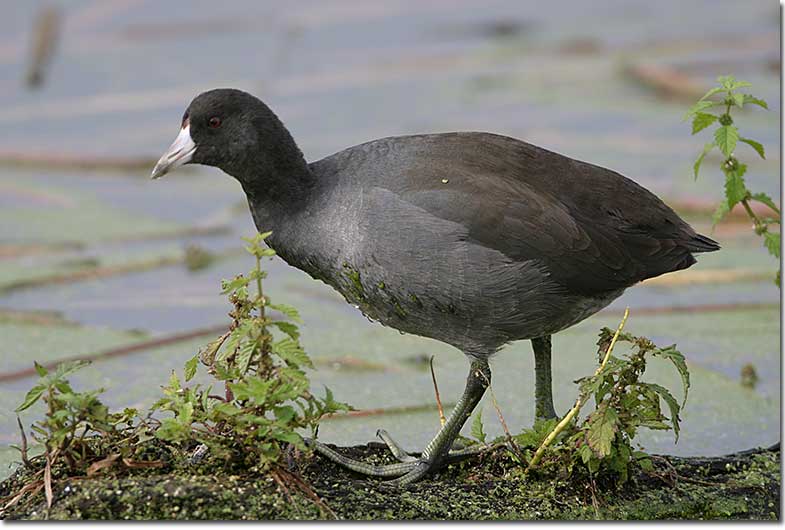
Scientific name: Fulica americana
Length: 15.5 inches
Weight: 1.4 pounds
Wingspan: 24 inches
Song: “reah reah rik rik cluck cluck cluck”
The American Coot is a blackish, duck-like bird with reddish eyes, and small dark marks near the tip of its stubby, chalky white beak. Males and females look the same and have short tails with a bit of white, and greenish-yellow legs with semi-webbed toes.
In flight, this species shows a narrow white line on the trailing part of its rounded wings. Young birds are like adults but are more dull grayish overall.
American Coots feed on aquatic plants and small aquatic insects. They can also forage on land for corn and other types of grain but mostly pick vegetation from the surface of water while floating. Like ducks, they also dip below the water to feed.
This species uses aquatic plants to make a floating nest in marsh vegetation. That’s why it is one of the most common birds of Montana.
American Coots live on lakes, ponds, and shallow marsh habitats in many parts of Canada and the USA south to the Caribbean and Central America.
Key Identifications:
- Duck-sized blackish aquatic bird with a stubby white beak.
- Feeds on aquatic plants, grain, some insects, and some small aquatic creatures.
- Makes a floating nest from marsh vegetation.
- A vocal bird that makes lots of odd growling and clucking sounds, “reah reah rik rik cluck cluck cluck”.
The American Coot is a dark, duck-like aquatic bird with a stubby white beak. It feeds on aquatic vegetation and insects in lakes, marshes, and other shallow water habitats. When coots fly, they run on the water while quickly flapping their wings to become airborne.
Tree Swallow
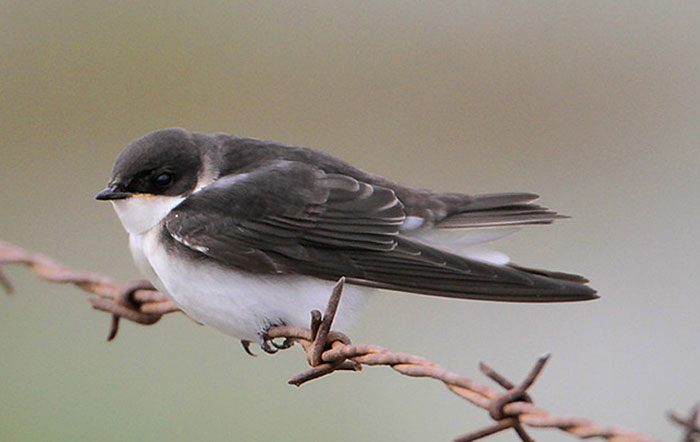
Scientific name: Tachycineta bicolor
Length: 5.75 inches
Weight: .7 ounces
Wingspan: 14.5 inches
Song: “ree ree reh chipeledup”
The Tree Swallow is a small swallow with metallic green-blue upperparts and white underparts. Males and females look alike and have blackish plumage in front of their eyes, long dark wings, and a dark, slightly forked tail.
Juveniles are grayish-brown above and pale below with a gray wash on their breast.
This swallow species feeds on small insects and often forage in loose flocks. They eat insects by catching them with their open mouth while flying over wetlands and other open habitats.
In winter, they can also eat seeds and bayberries.
Tree Swallows nest in tree cavities and nest boxes. They make a cup nest out of grass and other plant material, and line it with feathers.
This species occurs around ponds, lakes, rivers, and other wetlands. They are summer residents in Alaska, Canada, and most of the northern half of the USA (including Montana). In fall, they migrate to parts of the southern USA, the Caribbean, and Mexico.
Key Identifications:
- Small swallow that is dark green-blue above, white below, and has a shallow forked tail.
- Forages for insects by catching them in flight over wetland habitats.
- Nests in tree cavities and nest boxes.
- A vocal bird, the Tree Swallow makes bubbling sounds in flight and while perched, “ree ree reh chipeledup”.
Tree Swallows are dark green-blue above and white below. They often occur in groups that perch and fly above ponds, lakes, and other wetland habitats. In migration, thousands of Tree Swallows gather in the evening to form huge, swirling flocks before roosting in marsh vegetation.
Ring-billed Gull
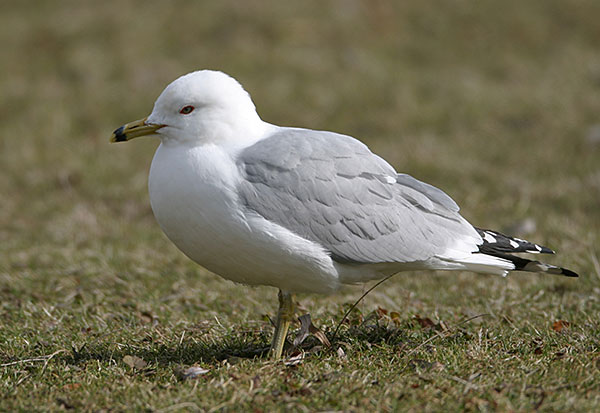
Scientific name: Larus delawarensis
Length: 17.5 inches
Weight: 1.1 pound
Wingspan: 48 inches
Song: “KLEE..KLEEE..kleeya,kleeya,kleeya”
The Ring-billed Gull is a medium-sized pale gray and white gull with a black ring around its yellowish beak. Males and females look the same and have yellowish legs and feet, pale eyes, and black wing tips with a few white spots.
These gulls have direct, fairly quick flight with leisurely wing beats. Young birds have pink and black bills, a white tail with a black tip, and mottled black and gray wings.
Ring-billed Gulls are scavengers and opportunists that feed on carrion, fish, worms, small animals, grain, and other food items. They usually occur in flocks that roam lakes, rivers, urban areas, and other habitats in search of feeding opportunities.
These gulls also gather in farm fields to feed on grain and worms.
The Ring-billed Gull breeds in colonies, often on islands, and makes a shallow stick nest on the ground.
This gull species occurs not only in Montana, but also in many parts of Canada and the USA south to Central America.
Key Identifications:
- Medium-sized pale gray and white gull with a black ring on its bill and yellow legs and feet. Juveniles have pink and black beaks.
- Forages for fish, carrion, and many other food items in wetlands and open habitats.
- Nests on the ground, in colonies.
- Ring-billed Gulls often call. In flight, they often make a high-pitched “kleea” sound. On the ground, displaying birds make a loud, laughing, “KLEE..KLEEE..kleeya,kleeya,kleeya”.
Ring-billed Gulls are pale gray and white, medium-sized gulls with a black ring around their beaks and yellow legs and feet. They are well adapted to living with people and occur around lakes, rivers, and other wetlands, parking lots, garbage dumps, and other places. This gull species is a bold bird that can snatch bits of food from unguarded picnic tables.
Gadwall
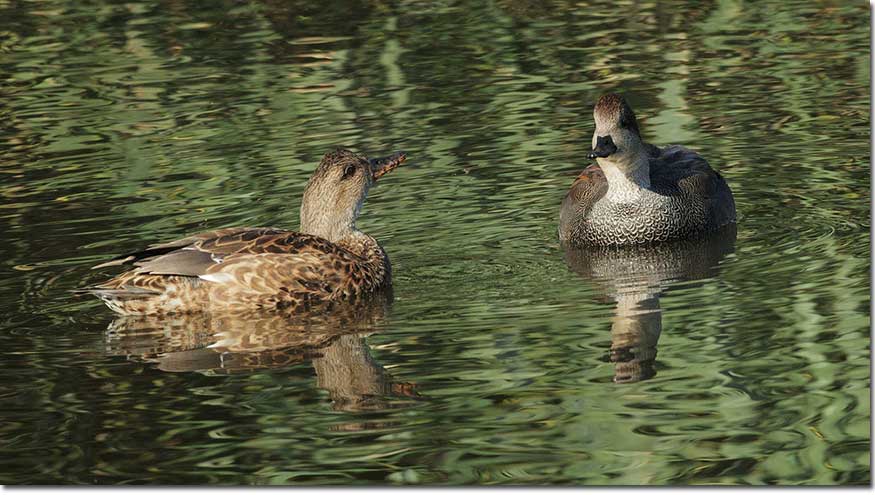
Scientific name: Mareca strepera
Length: 20 inches
Weight: 2 pounds
Wingspan: 33 inches
Song: “reh reh reh reh reh”
The Gadwall is an average-sized duck with a white belly and a small white patch in each wing. The male is gray with some tan on its wings, and has a pale, gray-brown head and black beak.
The male Gadwall also has a black rump and undertail. The female Gadwall is mottled gray-brown and buff with a plain grayish head, and has a gray and orange beak.
Gadwalls forage for seeds and aquatic plants by dipping below the surface and using their beaks to pick up food items. They often occur in flocks of a hundred or so birds.
This duck species nests on the ground in meadows and other areas with tall grass. It makes a shallow scrape hidden in dense vegetation.
The Gadwall breeds in wetlands in southern Alaska, and in western, central, and southern Canada. It also breeds in the western, central, and eastern USA, and winters in wetlands in the western, central, and southern USA.
Key Identifications:
- Gray duck with a black beak, black rump and undertail (the male), or buff and gray-brown with an orange and gray beak. Both sexes have a white belly and small white wing patch.
- Dabbles for aquatic plants and seeds in wetlands.
- Makes a shallow scrape on the ground in meadows and other spots with dense grassy vegetation.
- Makes nasal, rasping quacking calls, “reh reh reh reh reh”.
The Gadwall is a grayish or buff and brown duck with a white belly and a small white wing patch. This species frequents a variety of wetland habitats, often in loose flocks of 100 or so. This duck steals food from coots and other ducks.
Common Merganser
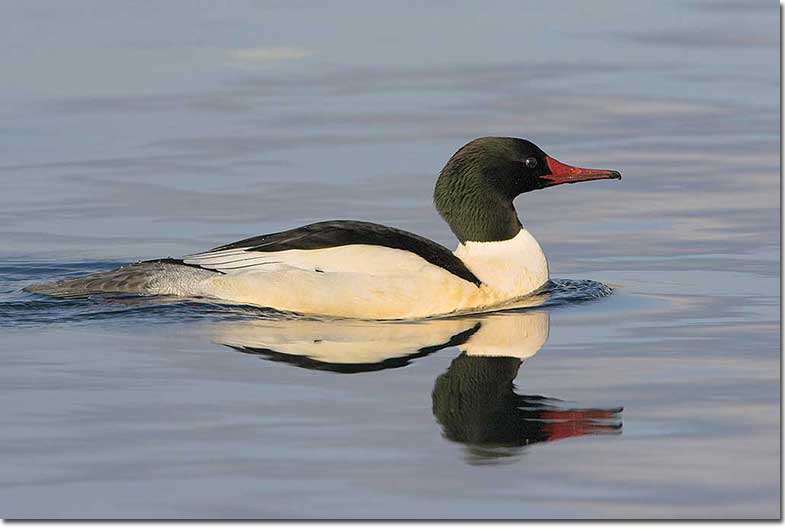
Scientific name: Mergus merganser
Length: 25 inches
Weight: 3.4 pounds
Wingspan: 34 inches
Song: “kook kuh ruh rah ruh rah”
Common Mergansers are big diving ducks with pointed red-orange beaks and a large white patch in each wing.
Breeding males are ivory-white with a glossy black-green head. They also have a black and white back and wings, and a wedge-shaped gray tail.
Females, juveniles, and non-breeding males are gray and have a white belly, brown head, and white throat.
Common Mergansers eat small fish and also catch insects, crustaceans, and other small animals. They forage by diving below the surface and snatching prey with their long, hooked beak.
This species nests in tree cavities and other holes and crevices. They line the bottom of the nest hole with wood chips and down feathers.
The Common Merganser breeds in forested lakes and rivers in Alaska, Canada, and the northern and western USA. This species winters on lakes, reservoirs, and coastal waters in Canada and the northern and western USA.
Key Identifications:
- Large black and white or gray and white duck with a dark head and a pointed red-orange beak.
- Dives underwater to catch small fish and other small animals.
- Nests in a woodpecker hole or other cavities in forested areas near lakes and rivers.
- Occasionally makes croaking sounds, ““kook kuh ruh rah ruh rah””.
This duck is common on northern and western lakes, big rivers, and reservoirs. Common Mergansers are also known as Goosanders, Sawbills, and Fish Ducks.
FAQ
What kind of birds are there in Montana?
There are many kinds of birds in Montana. There are special grassland species like Sprague’s Pipit and longspurs, Golden Eagles and other raptors, and montane birds like the Gray-crowned Rosy-Finch.
What is the most common bird in Montana?
The most common bird in Montana is the Black-billed Magpie. According to eBird sightings, this species has been seen more than any other bird species in the state.
What bird is Montana known for?
Montana is known for its state bird, the Western Meadowlark. It is also known for the Black-billed Magpie, and raptors like the Bald Eagle and the Golden Eagle.
How many species of birds live in Montana?
445 bird species have been found in Montana.
Let us know in the comments which one of these is your favorite.

